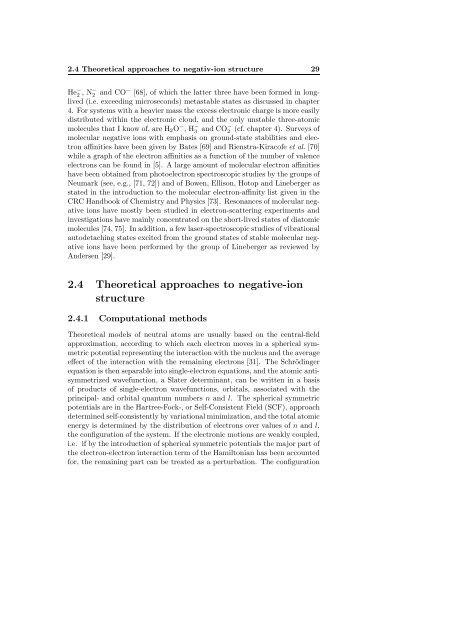VUV Spectroscopy of Atoms, Molecules and Surfaces
VUV Spectroscopy of Atoms, Molecules and Surfaces
VUV Spectroscopy of Atoms, Molecules and Surfaces
Create successful ePaper yourself
Turn your PDF publications into a flip-book with our unique Google optimized e-Paper software.
2.4 Theoretical approaches to negativ-ion structure 29<br />
He − 2 ,N− 2 <strong>and</strong> CO− [68], <strong>of</strong> which the latter three have been formed in longlived<br />
(i.e. exceeding microseconds) metastable states as discussed in chapter<br />
4. For systems with a heavier mass the excess electronic charge is more easily<br />
distributed within the electronic cloud, <strong>and</strong> the only unstable three-atomic<br />
molecules that I know <strong>of</strong>, are H2O− ,H − 3 <strong>and</strong> CO−2 (cf. chapter 4). Surveys <strong>of</strong><br />
molecular negative ions with emphasis on ground-state stabilities <strong>and</strong> electron<br />
affinities have been given by Bates [69] <strong>and</strong> Rienstra-Kirac<strong>of</strong>e et al. [70]<br />
while a graph <strong>of</strong> the electron affinities as a function <strong>of</strong> the number <strong>of</strong> valence<br />
electrons can be found in [5]. A large amount <strong>of</strong> molecular electron affinities<br />
have been obtained from photoelectron spectroscopic studies by the groups <strong>of</strong><br />
Neumark (see, e.g., [71, 72]) <strong>and</strong> <strong>of</strong> Bowen, Ellison, Hotop <strong>and</strong> Lineberger as<br />
stated in the introduction to the molecular electron-affinity list given in the<br />
CRC H<strong>and</strong>book <strong>of</strong> Chemistry <strong>and</strong> Physics [73]. Resonances <strong>of</strong> molecular negative<br />
ions have mostly been studied in electron-scattering experiments <strong>and</strong><br />
investigations have mainly concentrated on the short-lived states <strong>of</strong> diatomic<br />
molecules [74, 75]. In addition, a few laser-spectroscopic studies <strong>of</strong> vibrational<br />
autodetaching states excited from the ground states <strong>of</strong> stable molecular negative<br />
ions have been performed by the group <strong>of</strong> Lineberger as reviewed by<br />
Andersen [29].<br />
2.4 Theoretical approaches to negative-ion<br />
structure<br />
2.4.1 Computational methods<br />
Theoretical models <strong>of</strong> neutral atoms are usually based on the central-field<br />
approximation, according to which each electron moves in a spherical symmetric<br />
potential representing the interaction with the nucleus <strong>and</strong> the average<br />
effect <strong>of</strong> the interaction with the remaining electrons [31]. The Schrödinger<br />
equation is then separable into single-electron equations, <strong>and</strong> the atomic antisymmetrized<br />
wavefunction, a Slater determinant, can be written in a basis<br />
<strong>of</strong> products <strong>of</strong> single-electron wavefunctions, orbitals, associated with the<br />
principal- <strong>and</strong> orbital quantum numbers n <strong>and</strong> l. The spherical symmetric<br />
potentials are in the Hartree-Fock-, or Self-Consistent Field (SCF), approach<br />
determined self-consistently by variational minimization, <strong>and</strong> the total atomic<br />
energy is determined by the distribution <strong>of</strong> electrons over values <strong>of</strong> n <strong>and</strong> l,<br />
the configuration <strong>of</strong> the system. If the electronic motions are weakly coupled,<br />
i.e. if by the introduction <strong>of</strong> spherical symmetric potentials the major part <strong>of</strong><br />
the electron-electron interaction term <strong>of</strong> the Hamiltonian has been accounted<br />
for, the remaining part can be treated as a perturbation. The configuration















